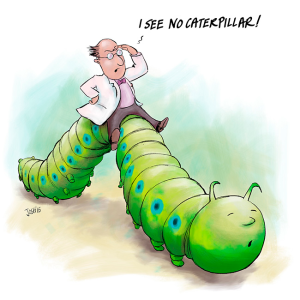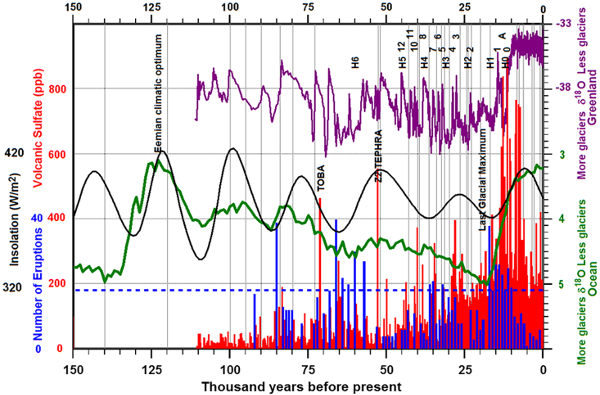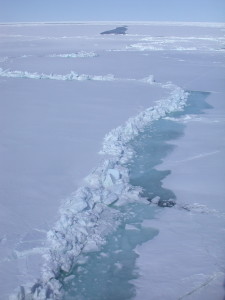Beryllium-10 is a radioactive isotope of beryllium most scientists believe is formed in the earth’s atmosphere by cosmic rays. It has a half life of 1.39million years. I therefore follows that whilst an increase in Cosmic rays will increase the percentage Beryllium-10, even a total absence of cosmic rays will cause only a very mild and gentle decline in the concentration of Beryllium-10 in the atmosphere.
Below is a plot of the percentage of Beryllium-10 found in Greenland ice-cores running from 22,000 to 10,000 years before present (third line up). together with O18 (a possible proxy for temperature) and a “normalised” flux. Note the time scale is right to left. The method for normalising isn’t outlined, but I assume it must be something that removes the the massive DECREASE in Beryllium-10 seen at 14,700BP.

Note time right to left. From Persistent link between solar activity and Greenland climate during the Last Glacial Maximum Adolphi et al.2014
Surprisingly there is nothing I can see in the paper about this MASSIVE drop in the Beryllium-10 levels except the following:
The difference of 10Be concentrations and fluxes reflects the known effects of snow accumulation rate changes on ice-core 10Be concentration, especially visible at transitions between stadials and interstadials
This doesn’t seem to me to be an explanation of the drop from about 3.5 atoms per gram to about 0.5atoms per gram at 17,000BP. Given a half life of 1.37million years I calculate given the half life such a massive drop would have taken 4million years.
Cosmic rays cannot directly explain this change: an increase would see more Beryllium-10 and an absence would see a very slow decline. Where then is there a potential explanation?
One simple one is that the Beryllium-10 was diluted by the normal isotopes of Beryllium from another source. Given the half life, this implies there was a source of Beryllium much greater than 4million years old. This age would not be consistent with ice-age melting which appears to be the explanation in the paper as the melting ice would contain Beryllium that is far too young at about 100,000 years old. It is therefore a very old source and if it consisted entirely of extremely old Beryllium with no Beryllium-10 isotope, this source would have to form 86% of all Beryllium found in the ice-core after 14,700BP.
Such a vast input of fresh Beryllium suggests one of three possible source:
- A massive meteorite with sufficient Beryllium to almost completely dilute all the Beryllium on the surface of the earth. I don’t know of anything else that suggests this.
- Some change in geography such that a source extremely rich in Beryllium suddenly became exposed and was completely eroded over a few thousand years again it seems unlikely.
- Volcanic or tectonic activity. And this is well supported both by the evidence below on volcanic activity as well as research into Beryllium 10 in hydrothermal vent deposits from the East Pacific Ridges: Role of sediments in the hydrothermal processes which shows Beryllium from hydrothermal vents can have almost no Beryllium-10.
It therefore seems likely that the massive dilution of Berryllium came about by some form of Volcanic activity that occurred at 14700BP.
The Caterpillar Effect
For more detail see The Caterpillar theory of tectonic plate movement – it’s just simple physics.

Thanks Josh cartoonsbyjosh.com
It is well known physics that when (most) materials heat they expand and when they cool they contract. This phenomenon is well known in geology where the yearly and daily temperature cycle it is responsible for the break up of rock particularly in higher mountains. The Caterpillar effect is merely a name for the same phenomenon over the broad area of the earth’s crust over the much longer time period it takes for the surface of the crust to change temperature. For example a 100,000 year cycle will penetrate many kilometres into the earth. Like mountain rocks, the change is relatively small, but when it occurs across the whole face of the globe the total expansion and contraction can be several kilometres. This creates pressure where one plate is being pushed under another and so it increases the subduction when there is thermal expansion and decreases it when there is thermal contraction. It also appears to modulate mid-oceanic ridge formation in a similar manner with an increase when the crust is thermally contracting. A similar effect is seen on floating ice where daily cycling of temperature expands and contracts the ice causing the ice-pressure zones shown above.
If during the contraction phase mid-oceanic crust wells up to fill the voids, the process will cause a step-wise expansion contraction movement of the crust in one direction. Hence the name “Caterpillar effect” in reference to the way some caterpillars move.
It is therefore predicted that the rate of volcanic activity will change over the ice-age cycle and there is evidence for this in the variation of mid-oceanic ridge formation (below)
It is also predicted that there will be an increase in volcanic activity which I first showed from Lund et al (2016). As I predicted it clearly shows an increase in volcanic activity (blue=number of eruptions, red=Volcanic sulphate) during the warming phase (Green and top purple is number of glaciers):
 This new evidence however has much finer detail and now however the Beryllium-10 evidence appears to shows a massive increase in volcanic activity within the same century as the O18 indicates a rise in temperature. This is no longer a smoking gun somewhere in the vicinity of the end of the ice-age, this is the volcanos having been caught red handed with the gun in the hand, so to speak.
This new evidence however has much finer detail and now however the Beryllium-10 evidence appears to shows a massive increase in volcanic activity within the same century as the O18 indicates a rise in temperature. This is no longer a smoking gun somewhere in the vicinity of the end of the ice-age, this is the volcanos having been caught red handed with the gun in the hand, so to speak.
Caterpillar Ice-age trigger Hypothesis
The ice-age trigger hypothesis is that the cold of the ice-age caused the crust to shrink progressively massively reducing volcanic activity. It is then hypothesised that as the crust began to thermally stabilise, that the threshold amount of surface warming required to “turn the tables” and cause the crust to have net expansion dropped until a relatively small amount of warming could trigger a change in phase in the crust. For this to happen there would need to be a large scale positive feedback such that volcanic activity caused warming and that warming caused more volcanic activity so that we had runaway warming – until the inter-glacial where this “runaway warming” obviously stopped, presumably because when it warmed sufficiently some kind of “hard stop” came into play effectively bringing the “runaway warming” to an end.
There is two big hole in this theory: 1) identifying a suitable candidate for the positive feedback. 2) the “hard stop”. There positive feedbacks are not too difficult as there are obvious ones like a change in albedo whereby melting snow absorbed more heat. Another is a change in atmospheric humidity as ice-covered water was exposed and began to evaporate. Another is greenhouse gases – but the scale of change for CO2 is far too small to account for the change. However that such positive feedbacks are present at the end of an ice-age is really not doubted.
The hard stop is more difficult. I personally suspect that there was a change in climatic circulation allowing a lot more sun-shielding cloud to form.



